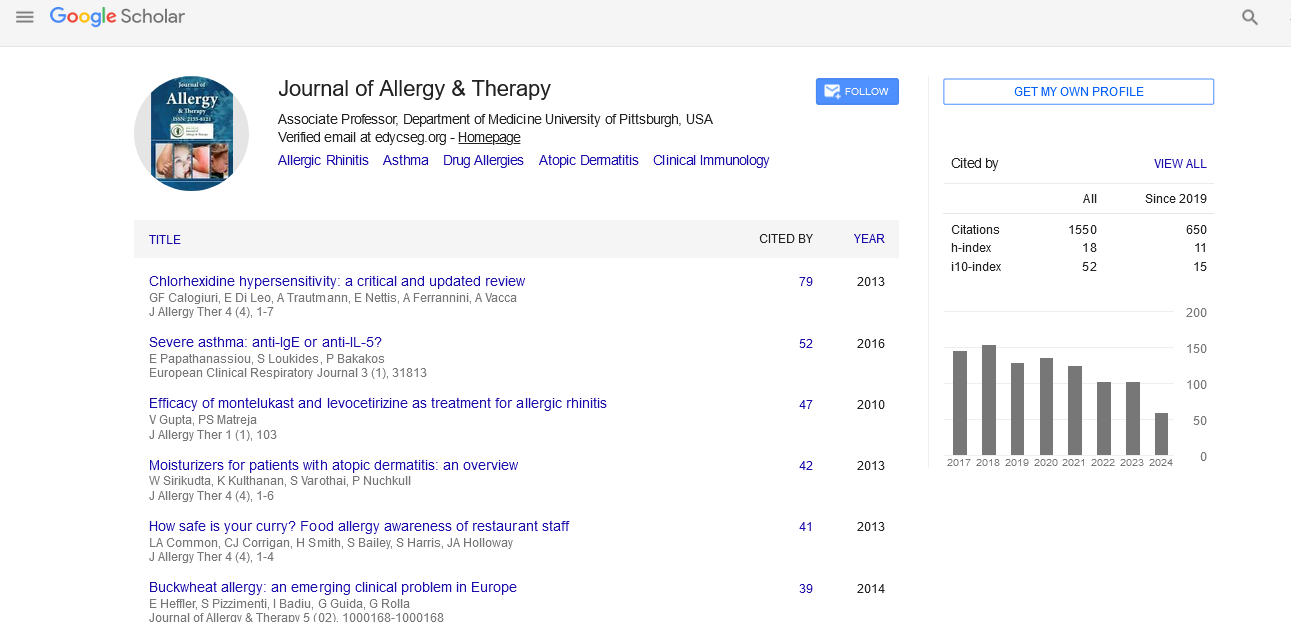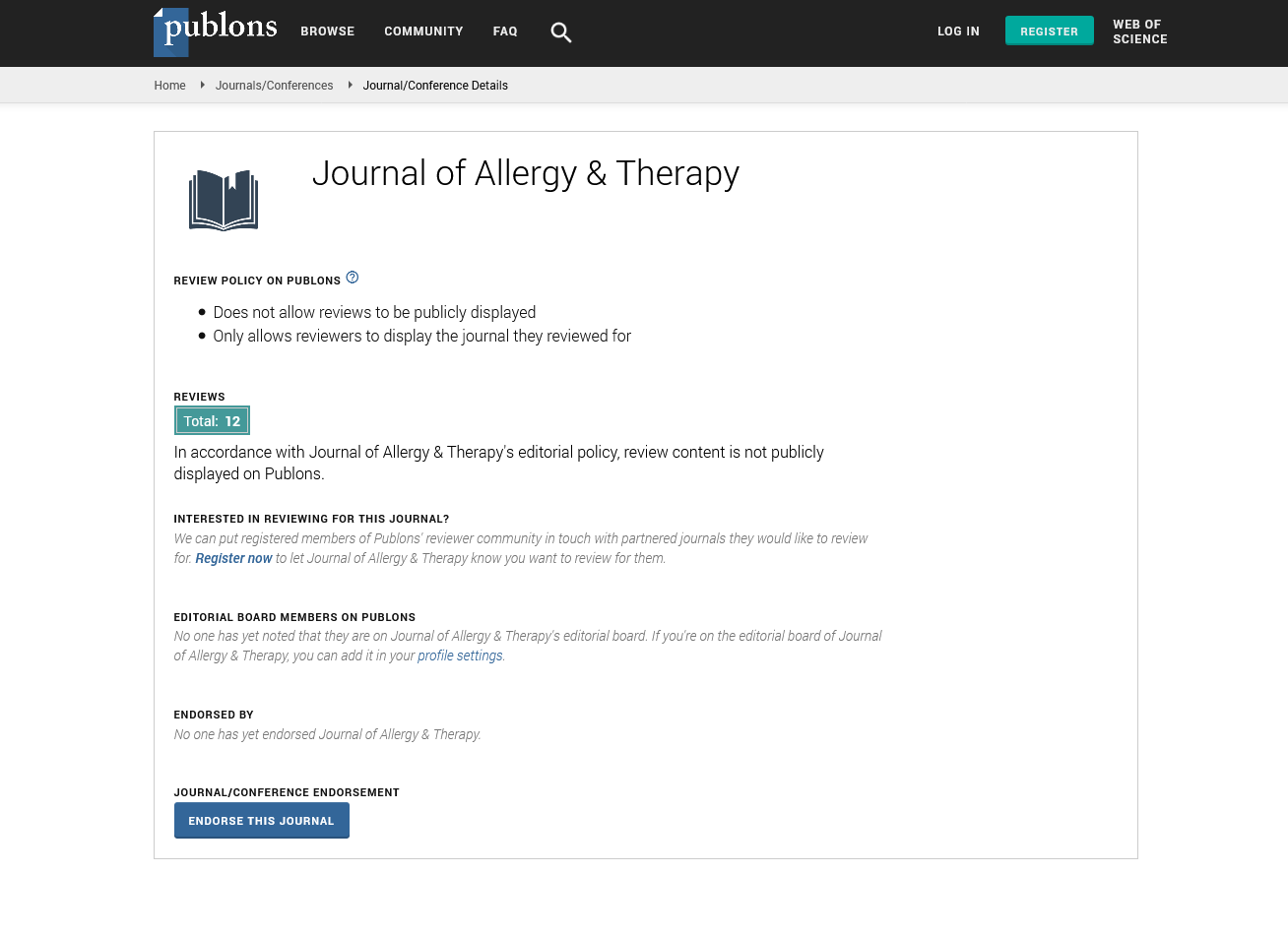Indexed In
- Academic Journals Database
- Open J Gate
- Genamics JournalSeek
- Academic Keys
- JournalTOCs
- China National Knowledge Infrastructure (CNKI)
- Ulrich's Periodicals Directory
- Electronic Journals Library
- RefSeek
- Hamdard University
- EBSCO A-Z
- OCLC- WorldCat
- SWB online catalog
- Virtual Library of Biology (vifabio)
- Publons
- Geneva Foundation for Medical Education and Research
- Euro Pub
- Google Scholar
Useful Links
Share This Page
Journal Flyer

Open Access Journals
- Agri and Aquaculture
- Biochemistry
- Bioinformatics & Systems Biology
- Business & Management
- Chemistry
- Clinical Sciences
- Engineering
- Food & Nutrition
- General Science
- Genetics & Molecular Biology
- Immunology & Microbiology
- Medical Sciences
- Neuroscience & Psychology
- Nursing & Health Care
- Pharmaceutical Sciences
Commentary - (2025) Volume 16, Issue 1
The Evolution of Immunotherapy: From Historical Foundations to Modern Practice
Hans Frederiksen*Received: 31-Jan-2025, Manuscript No. JAT-25-27992; Editor assigned: 03-Feb-2025, Pre QC No. JAT-25-27992; Reviewed: 17-Feb-2025, QC No. JAT-25-27992; Revised: 24-Feb-2025, Manuscript No. JAT-25-27992; Published: 03-Mar-2025, DOI: 10.35248/2155-6121.25.16.409
Description
The field of immunotherapy has undergone remarkable transformations since its inception in the early 20th century. This review explores the journey from early allergen exposure experiments to contemporary targeted biological therapies, highlighting key developments that have shaped our current understanding and practice of allergy treatment. The concept of immunotherapy was first introduced by Leonard Noon in 1911, when he demonstrated that subcutaneous injections of grass pollen extract could reduce allergic symptoms. This groundbreaking discovery laid the foundation for what would become a cornerstone of allergy treatment.
Early practitioners faced significant challenges, including limited understanding of immune mechanisms and crude extraction methods, yet their pioneering work established fundamental principles that continue to guide modern practice. The mid-20th century brought significant advances in our understanding of immunological mechanisms. This breakthrough led to the development of more targeted therapeutic approaches and improved diagnostic techniques. The subsequent identification of cytokines, particularly the role of Interleukin (IL)-4 and IL-13 in allergic inflammation, further refined our understanding of the underlying pathophysiology. Modern immunotherapy has evolved to encompass various administration routes, including Subcutaneous (SCIT), Sublingual (SLIT) and more recently, Epicutaneous Immunotherapy (EPIT). Each method offers distinct advantages and limitations, catering to different patient populations and allergic conditions. The advent of molecular allergology has enabled component-resolved diagnostics, allowing for more precise patient selection and treatment customization.
The emergence of biologics has marked a new era in immunotherapy. Monoclonal antibodies targeting specific immune pathways, such as anti-IgE (omalizumab) and anti-IL-5 therapies (mepolizumab, reslizumab), have demonstrated remarkable efficacy in treating severe allergic conditions. These targeted approaches have revolutionized the treatment of severe asthma and other allergic disorders resistant to conventional therapies. Recent advances in allergen modification technologies have led to the development of hypoallergenic variants and allergoids, which maintain immunogenicity while reducing the risk of adverse reactions. The role of adjuvants in immunotherapy has evolved significantly, with traditional aluminum hydroxide adjuvants being supplemented or replaced by novel compounds designed to enhance efficacy and modify immune responses more precisely. Toll-like receptor agonists, in particular, have shown promise in promoting beneficial Th1-type responses. Biomarker development has become increasingly important in patient selection and monitoring, with the identification of specific molecular and cellular markers helping to predict treatment response and optimize dosing strategies. Several challenges persist in the field of immunotherapy. Treatment duration continues to be a significant barrier to patient compliance, with traditional protocols requiring 3-5 years of regular administration. Research into accelerated protocols and novel delivery systems aims to address this limitation while maintaining safety and efficacy. The field is also witnessing increased interest in combining different therapeutic approaches, such as the use of biologics as adjunctive therapy during allergen immunotherapy. Looking ahead, several emerging technologies hold promise for further advancing the field, including the application of artificial intelligence in predicting treatment responses, development of novel delivery systems, and integration of microbiome modification strategies. The COVID-19 pandemic has influenced immunotherapy practices, leading to increased interest in home-based administration options and modified protocols that reduce in-person visits while maintaining treatment efficacy. The future of immunotherapy likely lies in increasingly personalized approaches, with treatment selection based on detailed patient phenotyping and biomarker profiles.
Conclusion
This precision medicine approach, combined with technological advances in allergen modification and delivery systems, promises to enhance both the safety and efficacy of immunotherapy. Cost considerations play a significant role in treatment accessibility, particularly for newer biological therapies, and future developments must balance therapeutic innovation with practical implementation considerations. The field of immunotherapy has evolved from its early experimental beginnings to a sophisticated therapeutic approach incorporating multiple modalities and delivery systems. While significant challenges remain, ongoing technological advances and improved understanding of immune mechanisms continue to enhance treatment options for allergic diseases. The future promises even more targeted and effective therapeutic strategies, moving closer to the goal of permanent tolerance induction for allergic conditions.
Citation: Frederiksen H (2025) The Evolution of Immunotherapy: From Historical Foundations to Modern Practice. J Allergy Ther. 16:409.
Copyright: © 2025 Frederiksen H. This is an open-access article distributed under the terms of the Creative Commons Attribution License, which permits unrestricted use, distribution, and reproduction in any medium, provided the original author and source are credited.


